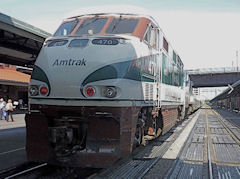Yes, it is possible to be a conservative and support high-speed rail in the United States. Indeed, in a paper prepared for the American Public Transportation Association, “High-Speed Rail: A Conservative Appraisal,” conservatives William S. Lind and Glen D. Bottoms have outlined a practical, disciplined approach to build a better passenger rail system.
Rather than spending hundreds of billions of dollars to build a national, high-speed rail system and gamble that someone uses it, Lind and Bottoms urge an incrementalist approach that minimizes public investment. Instead of attempting to replicate Japan’s Tokaido Shinkansen (top speed 180 mph) or France’s Train a Grande Vitesse (top speed 200 mph) from scratch, they would make small, targeted investments to address rail bottlenecks with the goal of raising the average speed rather than the top speed. Higher average speeds and more reliable service will bring in more passengers and revenue, they argue, laying the groundwork for upgraded service and, eventually, for genuine high-speed rail in markets like the northeastern U.S. where existing (not hoped-for) rail traffic would support the investment.
“We face a choice,” they write, “a choice between ‘best’ and ‘good enough,” between true high-speed rail and higher speed rail. … We would choose the latter, restoring passenger rail to its former glory in a deliberate, incremental fashion.”
President Barack Obama’s ambition is to build a rail system serving 80% of the public — a project similar in magnitude to building the interstate highway network. As fiscal conservatives, Lind and Bottoms say that a nation hefting a $17 trillion national debt and running massive deficits cannot afford such a dream. They compare building such a system as top-down, cost-be-damned monument building worthy of a pharoah.
While some people look to high-speed service in Japan and Europe for inspiration, Lind and Bottoms look to the business models of the successful high-speed trains. The high-speed rail line between Paris and Lyon took only 12 years to pay for itself. The original forecast showed a 12% rate of return; the line ultimately posted at 15% rate of return. Likewise, the Tokaido Shinkansen, which connects Tokyo and Osaka, not only operates at a profit, it has earned enough to pay back its original construction costs in full.
As those cases demonstrate, high-speed rail can operate profitably. They can even pay their up-front capital costs, a hurdle that seems impossibly high in the United States. What many people forget is that those high-speed lines served existing markets that had arisen around slower trains. High-speed rail was not summoned by imperial decree from the desert.
The conservative way forward is to build incrementally on what already exists, gradually (and affordably) creating higher-speed rail. As ridership grows on a corridor, more trains are added and average speeds, but not necessarily top speeds, are raised. It costs far less, both in capital and for maintenance, to raise slow sections of track to the initial [Federal Railway Administration] speed limit of 79 mph than to try for “gee whiz” top speeds. The objective should be to make travel times competitive with the automobile, not to compete with airplanes. As business builds further, it may justify raising top speeds on some sections to the next notches on the FRA scale, first 90 mph, then 110. But speed increases should follow the market.
Lind and Bottoms point to three examples where the U.S. has done it right — the Cascades corridor connecting Portland, Oregon, and Seattle; the Hiawathas route between Chicago and Milwaukee; and the Downeasters between Portland, Maine, and Boston. The story in each case was one of making incremental improvements, shaving a few minutes off the travel time each each project. “All three of these corridors, as they continue to build ridership and offer more frequent trains, will at some point justify raising top speeds, from 79 mph to 90 or 110. That is how higher-speed rail works. It builds on success, not on oversold plans handed down by Pharaoh. ”
Lind and Bottoms concede that none of those routes fully covers its operating costs. The Downeasters does best, with a take of 86.7%. But the authors note that user fees, including the gas tax, cover only 51% of the cost of building and maintaining highways.
“As in the fable of the tortoise and the hare, slow and steady wins race,” they conclude. “The prudent, conservative way to true high-speed rail is through higher-speed rail.”
Bacon’s bottom line: Two points. First, it’s true that roads and highways are subsidized. However, rather than subsidizing both transportation modes, which makes it impossible to tell which is truly the most cost-efficient, we should try to create a level playing field in which each mode pays its own way. Only then can we allocate capital rationally.
Second, the Lind-Bottoms approach appears to be similar to that pursued in Virginia, where the Department of Rail and Public Transportation (DRPT) has cobbled together some of the most cost-effective passenger service outside the profitable Northeast corridor. I have not studied the matter closely, but DRPT appears to favor the incrementalist strategy of building routes step by step and making modest, affordable improvements on the Richmond-Washington route with a focus on reducing average travel time, not goosing top train speeds. It may be worth taking a fresh look at Virginia’s approach through a Lind-Bottoms lens.



